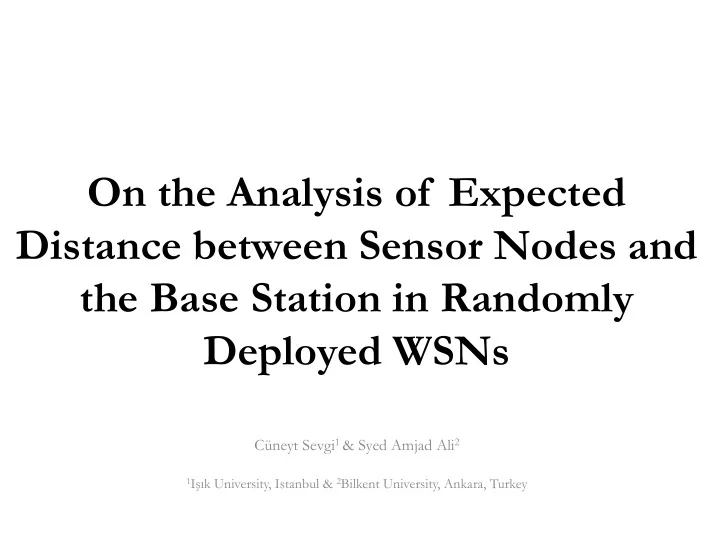

On the Analysis of Expected Distance between Sensor Nodes and the Base Station in Randomly Deployed WSNs Cüneyt Sevgi 1 & Syed Amjad Ali 2 1 Işık University, Istanbul & 2 Bilkent University, Ankara, Turkey
Agenda • Motivation of the study – Why determining the expected distance is important in randomly deployed WSNs? • Related work • Network Model • Our Approach – E[d toBS ] Derivation • Validation • Conclusion • Future Work
Why is Expected Distance important? • In a deterministic scenario, – the average distance between each node and its neighbors – Similarly, the average distance between each node and the BS are known in advance. • In random deployment scenarios, – these distances, are NOT known in advance.
Why is Expected Distance important? • In the random deployment scenarios, these distances, which indeed affect – the energy consumption The Energy-hole – the lifetime of an application problem – etc. 1
The energy-hole problem
The energy-hole problem
The energy-hole problem
The energy-hole problem
Why is Expected Distance important? • To find out the modes of communication adopted by the network. – the multi-hop communication – the direct communication (a.k.a., single-hop) 2
Why is Expected Distance important? • More importantly, E[d toBS ] value also has an important role particularly for the clustered RDWSNs . 3
Why is Expected Distance important? • In a clustering scheme, – sensor nodes are basically grouped into clusters based on • the proximity of the neighboring nodes, • the average distance to the BS, and energy levels, etc. to overcome some of the inherent challenges of WSNs. • But, how many clusters? – What is the optimum # of clusters ( k opt )?
What is the optimum # of clusters? • A notable work* in proposes a number of closed-form expressions to identify k opt . – provide a complete theoretical framework for characterization of k opt with respect to a set of parameters of the system scenario listed as follows: • the number of nodes to be deployed ( N ) • the area of sensing field ( A ) • E[d toBS ] . *Amini, N., Vahdatpour, A., Xu, W., Gerla, M., Sarrafzadeh, M.: Cluster size optimization in sensor networks with decentralized cluster-based protocols. Computer Communications 35(2), 207 – 220 (2012)
E[d n toBS ] n=1, n=2, and n=4 Outside the Field @ Perimeter @ Center (on the axis)
E[d n toBS ] n=1, n=2, and n=4 E[dtoBS] E[dtoBS] E[dtoBS] E[d 2 toBS] E[d 2 toBS] E[d 2 toBS] E[d 4 toBS] E[d 4 toBS] E[d 4 toBS]
Related Work • Low-Energy Adaptive Clustering Hierarchy ( LEACH ) – the pioneer work, influential* & well-known* – integrates the concept of energy-efficient cluster-based routing & medium access to prolong the system lifetime. *Tyagi, S., Kumar, N.: A systematic review on clustering and routing techniques based upon LEACH protocol for wireless sensor networks. Journal of Network and Computer Applications 36(2), 623 – 645 (2013)
Related Work • Low-Energy Adaptive Clustering Hierarchy ( LEACH ) – cluster head election by devising a mechanism that the cluster head role is rotated randomly among all the nodes in the network. • by consuming the energy in a balanced fashion • it prolongs the lifetime of the WSN applications – an approximate expression to determine the optimum number of clusters ( k opt ). – There are many variants of LEACH and many of non- LEACH protocols are benchmarked with LEACH.
Related Work Categorization of LEACH Related Routing Protocols for WSNs
Related Work Categorization of Cluster Head election for clusterbased routing protocols.
Related Work Categorization of multihop data transmission for clusterbased routing protocols.
Related Work Categorization of heterogeneous networks
Related Work Categorization of chain based routing protocols
Related Work • Regardless of – which clustering technique is employed or – similarly which communication mode (i.e., multi-hop or single-hop) is exploited or – whether heterogeneity is used • a WSN application can only take the advantage of clustering if and only if the application is grouped with the optimum number of clusters .
Network Model The nodes are randomly and uniformly deployed Before Clustering After Clustering
Network Model The nodes are randomly and uniformly deployed What is the optimum # of clusters? What is the Expected distances? Which energy scheme will be used (n=1, 2, 4)? Before Clustering After Clustering
E[d toBS ] Derivation In the Cartesian Coordinates
E[d toBS ] Derivation In the Polar Coordinates
E[d toBS ] = E[d toBS−tri ] +E[d toBS−trap ]
E[d toBS ] = E[d toBS −tri ] +E[d toBS −trap ]
E[d toBS ] = E[d toBS −tri ] + E[d toBS −trap ]
E[d toBS ] = E[d toBS −tri ] +E[d toBS −trap ]
Validation • We have validated our analytical results with simulations. • We have double checked the boundary values with the previous works.
What if k=0?
Conclusion • We formulated E[d toBS ] when – sensor nodes are deployed randomly & uniformly over a square-shaped sensing field – the BS is located outside the field. • The formulation of E[d toBS ] is important – the calculation of the k opt – the decision whether multi-hop or direct communication – can be also exploited in any domain when there is a need for a probabilistic approach
Future Work • One of the limitations of E[d toBS ] derivation in this paper is that the BS is assumed to be located on the axis of (outside) the sensing field. • Our future work will explore E[d toBS ] when the BS is located at any arbitrary point outside the sensing field. • Any given random probability distribution. – Not only uniform distribution
Future Work Arbitrary point Outside the Field Outside the Field (on the axis)
Questions & Suggestions • Thanks for attending • For further questions – csevgi@isikun.edu.tr
Recommend
More recommend